14
Ring BarkerCirca 1946
Powell River, British Columbia, Canada
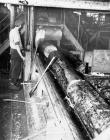 Credits:
Credits:P01645
Catalyst Paper, Powell River Division
Dino Aprilis
15
The logs that go to the saw mill can be converted into blocks for the Grinder Rooms, or cants which can be handled by the chipper. From the Chipper Building, if we follow the chips, we go up a conveyor belt to the chip surge bins in the Chip Screen Building. This lies alongside the hot fuel belt in the bridge. Friendly like, is the chip conveyor belt, carrying chips from the screens to the Digester House.Men and Paper
Vol. 1, No. 5
June 14, 1946
16
Chips on conveyorCirca 1940
Powell River, British Columbia, Canada
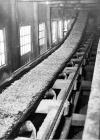 Credits:
Credits:P01676
Catalyst Paper, Powell River Division
Lionel Hanson
17
Often a high school students introduction to mill work began on the block loaders. It was a great lesson about what happens when machinery controls you, not when you control the machinery. Just about the time you were getting bored and tired and ready for a break, the damn thing would go into warp speed and spit out a tremendous pile of wood that had to be straightened in your little work space or the big guys beside and across from you would have to do it for you. And they always seemed to be in a bad temper. And, of course, you were reminded of the last guy who didn't pull his weight and went home with a picaroon buried in his head.18
Sorting blocksCirca 1940
Powell River, British Columbia, Canada
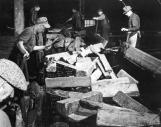 Credits:
Credits:P01607
Catalyst Paper, Powell River Division
John Campbell
19
Unnoticed often in the steady purr of the paper machines, the crushing roar of the barkers, the slushy immensity of the digesters, the howitzer like magnitude of the grinders, the great furnace of the steam plant, is another vital "pawn" in the manufacturing of Powell River newsprint-the filing room.Daily, in the two eight-hour shifts, close to half a million feet of logs are sawn, ripped and cut in the Powell River sawmill. Logs varying in diameter from one to six feet are bumped boisterously on to the carriage and "shot gunned" through the big 16-in band saws. They pass through the edgers to be cut longitudinally-and then on to the "slasher" for cutting into block size.
Little imagination is required to picture the wear and tear of this incessant friction on the saws, and the necessity of having fresh relays of sharpened edges ready to throw in at regular intervals. And here it is that the filing room, under the head filer and his capable assistants, swing into action.
Powell River Digester
Vol. 15 No. 2
February, 1939
20
Saw filing roomCirca 1930
Powell River, British Columbia, Canada
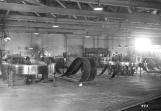 Credits:
Credits:P04623
Catalyst Paper, Powell River Division
Bob McGougan
21
The maintenance routine on a 10-foot head rig band saw is typical. The designation "10-foot" refers to the diameter of the top and bottom wheels of the band saw. The actual length of the 16" wide band saw blade itself is nearly 60 feet and it has 286 teeth, one every 2 ½ inches. When the teeth are merely dull, a grinding stone is adjusted to the shape of the tooth and the saw can then be sharpened automatically. But on every third visit of the saw to the filing room the teeth must be individually rebuilt.This intricate operation requires a high degree of experience and knowledge. Each tooth must be had swaged, an operation in which the steel is hammered to the correct thickness using a high pressure air anvil. The teeth are then individually shaped and, finally, sharpened.
Powell River Digester
Vol. 15, No. 2
February, 1939
22
Band saw sharpeningCirca 1987
Powell River, British Columbia, Canada
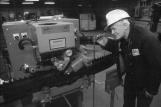 Credits:
Credits:S762
Ian Cameron, photographer
Bob McGougan
23
This pile of blocks represents one day's supply of groundwood for the eight newsprint machines in operation in the 1950's at the Powell River mill.24
One days supplyCirca 1950
Powell River, British Columbia, Canada
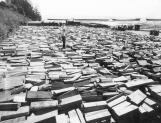 Credits:
Credits:P01673
Catalyst Paper, Powell River Division
25
Gerlinger Carriers were often seen buzzing about the mill and up the hill from the woodroom area. They were used to transport blocks from the block loaders in the wood mill to the grinder rooms. In the background are wood stave tanks used to store ground wood pulp from the grinder rooms.26
Gerlinger CarrierCirca 1940
Powell River, British Columbia, Canada
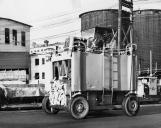 Credits:
Credits:P01636
Catalyst Paper, Powell River Division